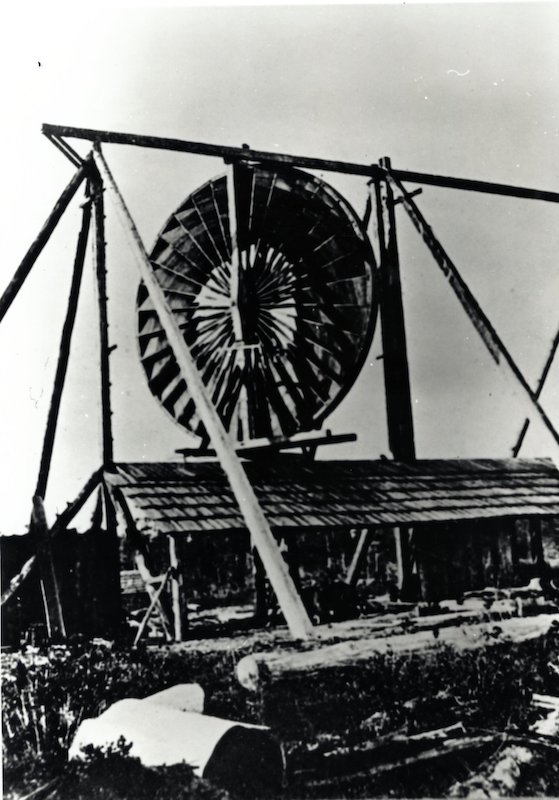
The wind-driven sawmill built and operated by William Heeser on Little Lake Road
originally published July 2, 1992
One of the strangest windmills erected in the Mendocino area produced not one drop of water for a residence or a store building. It ran a sawmill.
When William Heeser came to Mendocino from Napa County in 1857 to purchase for $6,000 some of the landholdings of William Kelley, he recalled the windmills of Germany he’d been fascinated with as a youngster. He decided to put the wind to work for him as a lumberman. Whether he designed the windmill pictured in the accompanying photograph or had someone else design it for him, I don’t know. [Interesting fact – the negative of this picture of Heeser’s wind-powered sawmill was found by Buzzy Parsons under the high school gymnasium.]
There were lots of trees on or near his apple orchards on Little Lake Road that could be depended upon to produce good lumber for Mendocino’s buildings, and a sawmill would come in handy. According to Francis Jackson, Heeser’s apple orchards were on both sides of the road two miles east of Mendocino.
Jackson doesn’t recall just where the Heeser mill stood (there are no traces of it), but he remembers Heeser’s apple dryer on the same property. The orchard Heeser planted and nurtured in the late 1850s or early 1860s is now known as Bean’s Orchard. [William Heeser’s wind-powered sawmill was located just north of the current Woodlands Kennel. Bean’s Orchard was located where the #750 Forest Service Road and Little Lake Road intersect. The orchard is now overgrown with trees and brush, but some of the fruit trees still survive in 2023.]
Heeser’s huge windmill may have looked slightly ridiculous, but it worked…whenever a strong wind was blowing. During periods of calm, Heeser had to shut down his sawmill.
There were three other sawmills in Mendocino at various times, all of them erected by Heeser’s compatriot, Jerome Ford, who moved the “works” for the first one here from Bodega Bay in the early 1850s. But none of Ford’s sawmills was wind-powered, so all were able to process redwood and fir and pine logs for an indefinite time whenever logs could be floated down Big River.
Just how long Heeser’s sawmill turned logs into boards, I have no idea, but the scale of the windmill dwarfed all others in Mendocino.
If you would like to see the size of a standard windmill blade, there is currently one on display in the Water Tower Wonderland Exhibit at the Kelley House Museum.
The Kelley House Museum is open from 11AM to 3PM Thursday through Monday. If you have a question for the curator, reach out to curator@kelleyhousemuseum.org to make an appointment. Walking tours of the historic district depart from the Kelley House regularly.